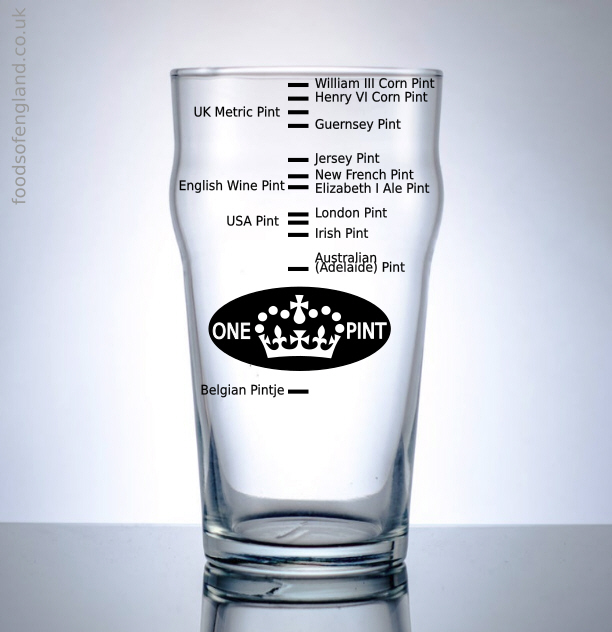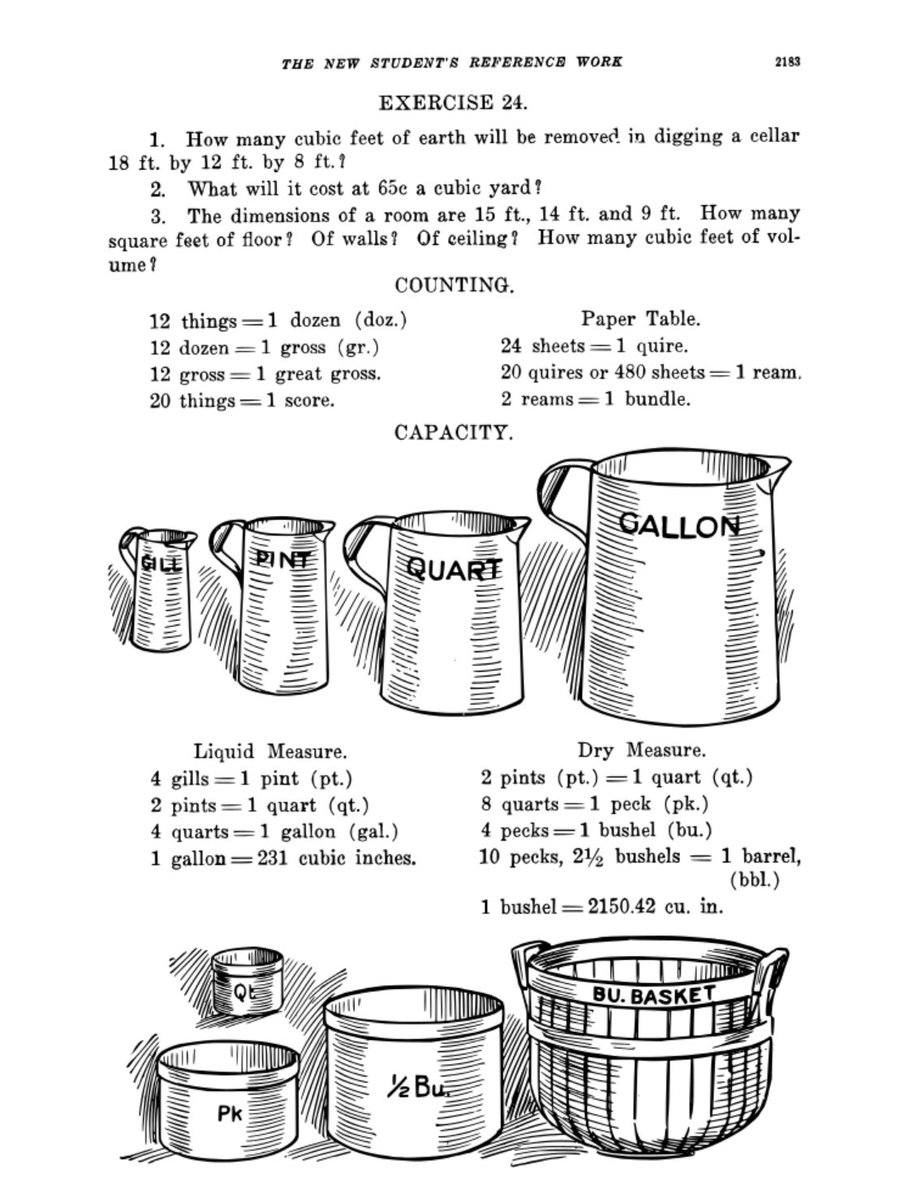

|
 Quite sure you know? Answer at the foot of the page English weights and measures are immense fun. Foods of England will (try) to explain…  THE MEASUREMENT SYSTEM It sometimes seems as if ‘British’ and ‘metric’ are two optional systems of measurement. But that’s not quite how things work… Once upon a time measurements were just based on, say, the length of King Hammurabbi’s leg, so every place was different, and you were never really quite sure what you were getting. Then, in the 1600s an Italian-born Polish engineer, Tytus Liwiusz Burattini, came up with a system that would be exactly the same everywhere. He knew that a pendulum of a particular length always swings once per second. Call that length of pendulum ‘the measurement’, or, in Latin ‘metre’. Apply our ten-fingered counting (that’s ‘decimal’, Latin again) to this ‘metric’ and say that a box one metre cubed holds 1000 litres of water, each of which weighs 1 kilogramme. And there you’ve got the basic units of time, length, volume and weight, all from a measurement which anyone who can count up to 86,400 can work out for themselves. Easy. English measurements were always a mess. So in 1824 the UK decided to adopt the newfangled metric system and define all those pecks and roods and pints in terms based on the metre. But, being British, they decided to work out the length of the metre by themselves, resulting in the UK having a metre which was about 1/8in smaller than the one everyone else was using, until that was corrected by the Weights and Measures Act of 1878. Nowadays The Metric System, which just means ‘The Measurement System’, has moved away from using pendulums (which vary ever so slightly from place-to-place because of gravity) and has been extended to include more-or-less everything So all those customary measures like pints, bushels and roods have been fixed in metric terms, and if they’re counted by 10s, they’re ‘decimal’. (The aircraft industry is (probably) unique in using a decimal system which is not based on the metre, they use decimal inches, but we don’t need to know that here) PINTS Pints have got rather puzzling over the years. An attempt was made in the 1960s to introduce a definitive ‘Crown’ mark on glasses to identify true 568.3ml pints of beer. Which led to complaints that the pint included useless froth. So an alternative ‘line’ Crown mark was introduced, including an extra measure for froth. But how much froth is froth? So a third Crown Mark was introduced which measured the beer at the pump. This led to some pubs having three different ‘official’ Crown-marked ‘pints’ in use. Which led to harsh words, and UK adopting the international ‘CE’ guarantee system for pint glasses. Here’s where we think we’re up to with pints, but it does all get rather confusing, so we may be wrong… Old French Wine Pint (1790) = 952.0ml William III Winchester Corn Pint (1697) = 580.3ml Henry VII Winchester Corn Pint (1497) = 572.2ml UK (current) Metric Pint (1985) = 568.3ml Guernsey Pint (1650) = 555.0ml Jersey Pint (1562) = 514.5ml French wine ‘modern’ or ‘Jennie’ pint (1906) = 500.0ml Elizabeth I Ale Pint (1700) = 491.6ml Old English Wine Pint (1706) = 491.6ml London ‘Guildhall’ Pint (1600) = 476.8ml USA Pint (1707) = 473.0ml Irish Pint (1736) = 462.0ml Australian (Adelaide) Pint = 425.0ml Belgian Pintje (‘little pint’) = 250.0ml WINE BOTTLES There’s been a lot of trickery with sub-standard bottles over the years, that’s why the wine trades have got legislation to fix sizes. USA was first, EU followed. They’re more-or-less the same… Recently (2022) there’s been some puzzlement that fizzy wine isn’t sold in pints. Puzzling indeed as the ‘modern pint’ or 500ml is perfectly allowed for still wines, and common for Sauterne and Tokaj. Why the wine trade doesn’t allow fizzy wine pints I don’t know. Perhaps with all those Jeroboams, Magnums, Rehoboams and wotnot, they decided they’ve got enough bottle sizes. Rumour has it that Winston Churchill preferred his champagne in pints, but was that the English wine pint of 474ml, so less than a 568ml beer pint, or the ‘Jennie’ wine pint of 500ml, or perhaps a Old French wine pint of a more Churchillian 952ml? Australian plonk, of course, could be in the rather pitiful Adelaide pint of 425ml. The official European sizes are… Still wine – ml: 100, 187, 250, 375, 500, 750, 1 000, 1 500 Spirit drinks – ml: 100, 200, 350, 500, 700, 1 000, 1 500, 1 750, 2 000 Liqueur wine – ml: 100, 200, 375, 500, 750, 1 000, 1 500 Aromatised wine – ml: 100, 200, 375, 500, 750, 1 000, 1 500 Sparkling wine – ml: 125, 200, 375, 750, 1 500 Yellow wine – ml: 620 …but there are also some unofficial sizes with names, mainly used by hilariously posh people to show how wonderfully profligate they are.. Litres – Bottles – Fancy Name 1.5 – 2 – Magnum 3 – 4 – Double Magnum 3 – 4 – Jeroboam 4.5 – 6 – Rehoboam 6 – 8 – Methuselah 9 – 12 – Salmanazar 12 – 16 – Balthazar or Belshazzar 15 – 20 – Nebuchadnezzar 18 – 24 – Melchior 20 – 26 – Solomon 27 – 36 – Primat or Goliath 30 – 40 – Melchizedek or Midas CUPS In North America food recipes often give quantities in ‘cups’, so “what size is a cup?” The point of cups is that size doesn’t matter, as long as you use the same one all the way through. As best we can tell at the moment… 1 US Cup (Customary) – 236.6ml 1 US Cup (Official) – 240ml 1 ‘Imperial’ Cup – 250ml 1 Canadian Cup – 227ml ALL THOSE OTHER MEASURES There’s loads more to worry about. Like rods and cones. But this’ll have to do for the minute. And it may still be wrong LINEAR MEASURE – 1 inch – 0.0254 metre 1 foot (=12 inches) – 0.3048 metre 1 yard (=3 feet) – 0.9144 metre 1 (statute) mile (=1760 yards) – 1609.3 metre 1 (nautical) mile (=1.150779 miles) – 1852 metre CAPACITY MEASURE – 1 (imperial) fl. oz. (=1/20 imperial pint) – 28.41 ml 1 (US liquid) fl. oz. (=1/16 US pint) – 29.57 ml 1 (imperial) gill (=1/4 imperial pint) – 142.07 ml 1 (US liquid) gill (=1/4 US pint) – 118.29 ml 1 (imperial) pint (=20 fl. imperial oz.) – 568.26 ml 1 (US liquid) pint (=16 fl. US oz.) – 473.18 ml 1 (US dry) pint (=1/2 quart) – 550.61 ml 1 (imperial) gallon (=4 quarts) – 4546 ml 1 (US liquid) gallon (=4 quarts) – 3785 ml 1 (imperial) peck (=2 gallons) – 9092 ml 1 (US dry) peck (=8 quarts) – 8810 ml 1 (imperial) bushel (=4 pecks) – 36369 ml 1 (US dry) bushel (=4 pecks) – 35239 ml MASS or WEIGHT 1 grain – 0.000065 kg 1 dram – 0.001772 kg 1 ounce (=16 drams) – 0.02835 kg 1 Troy ounce (for precious things) – 0.0311034768 kg 1 pound (=16 ounces =7000 grains) – 0.45359237 kg 1 Troy Pound (=12 Troy ounces) – 0.37324172 kg 1 stone (=14 pounds) – 6.35 kg 1 quarter (=2 stones) – 12.7 kg 1 hundredweight (=4 quarters =112 lb.) – 50.8 kg 1 (long) ton (=2240 lbs) – 1016 kg 1 (short) ton (=2,000 lbs) – 907 kg  Lots more at: metricviews.uk https://metricviews.uk/2013/06/15/forgotten-british-and-irish-units/
 |
|
MORE FROM Foods of England... Cookbooks ● Diary ● Index ● Magic Menu ● Random ● Really English? ● Timeline ● Donate ● Royalty ● English Service ● Food Map of England ● Lost Foods ● Accompaniments ● Biscuits ● Breads ● Cakes and Scones ● Cheeses ● Classic Meals ● Curry Dishes ● Dairy ● Drinks ● Egg Dishes ● Fish ● Fruit ● Fruits & Vegetables ● Game & Offal ● Meat & Meat Dishes ● Pastries and Pies ● Pot Meals ● Poultry ● Preserves & Jams ● Puddings & Sweets ● Sauces and Spicery ● Sausages ● Scones ● Soups ● Sweets and Toffee ● About ... ● Bookshop ● Email: [email protected] COPYRIGHT and ALL RIGHTS RESERVED: © Glyn Hughes 2022 BUILT WITH WHIMBERRY |